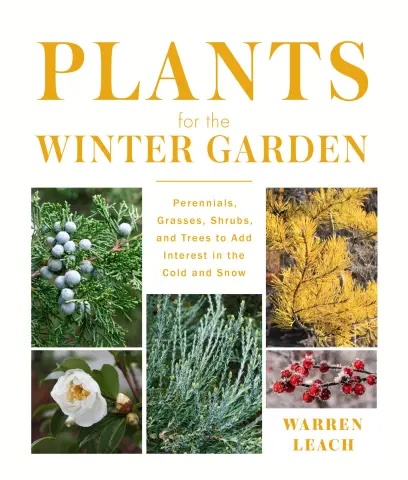Plants for the Winter Garden by Warren Leach. Portland, Oregon: Timber Press, 2024. 256 pp. Hardcover $40.00 list, $25.30 Amazon.
The topic of winter gardening has been covered previously by many writers. Adrian Bloom, Rosemary Verey and Val Bourne wrote in depth on the subject, despite being hampered by the lack of a “real” winter in their English climate. Eliot Coleman and Niki Jabbour taught us how to grow vegetables in winter with hoop houses and cold frames. Sydney Eddison’s The Unsung Season is a series of portraits of gardeners with some mention of how they garden in winter. Also, there are various publications like the Taylor gardening guides that provide lists of plants with winter interest.
Warren Leach wrote Plants for the Winter Garden from his landscape design perspective, with an almost total focus on gardens in New England, New York, and Pennsylvania. The title might easily have been Plants for Winter Gardens in the Northeast. For me this emphasis was enjoyable. I found few plants included that would not be hardy in my zone 5A upstate NY garden, and the landscapes he photographs are deeply familiar. NARGS readers from the South and West might find less that is useful in the book.
Leach’s writing is informative and personal. He tells us his own preferences and opinions. His writing is descriptive and sometimes poetic. As an occasional garden column writer, I sometimes despair of finding fifteen different ways of describing various flowers and buds. Leach has no such difficulty. As an example, take his description of Pieris japonica ‘Dorothy Wycoff’: “The vibrant buds… bring a jeweled display to its glossy green leaves. The entire branched panicle is crimson and studded with scarlet buds, arrayed like pendants set with pear-cut rubies.” Who would not want to grow such a plant?
The book is filled with beautiful pictures, including plant close-ups and garden views. Many private gardens were photographed, as well as a long list of botanic gardens and arboreta. A good number of photos show the plants in snowy gardens.
My favorite aspect of the book is its organization by plant characteristics rather than a simple listing of plants with winter interest. A tree or shrub might be described in the chapter on ornamental bark and then mentioned again in the chapter on decorative flower buds. A good index is also provided, so you can easily locate every mention of a particular species, if needed.
The first section of the book is on “Lasting Forms and Colors.” This is divided into chapters on Remnants (perennials and grasses visible in the snow), Evergreen Broadleafs and Conifers, Marcescent Foliage (plants that hang on to their dead leaves until spring), and Ornamental Bark. Much of this is familiar territory expertly covered. Leach’s long experience with northeastern winters leads him to note which ornamental grasses can stand erect despite deep snows, and the effect of low temperatures on foliage and bark colors. He discusses the quality of light reflection in various conifer and broadleaf trees and provides his own empirical knowledge of various species and cultivars.
Part Two, “Signs of Life,” includes Emergent Flower Buds, Winter-Blooming Trees and Shrubs, Winter Fruits, and Persevering Perennials. Part three on structure focuses on design concepts. It discusses entry gardens, views through windows, groves of trees, fastigiate forms, and shapes (clipped, pleached and espaliered). The chapters on groves and fastigiate trees were my favorites, with Leach’s in-depth discussion of the “gestalt of groves” and the design impact of fastigiate forms. Part four wraps up the book with coverage of planting permanent pots and protecting plants from winter damage.
Plants for the Winter Garden is a well-written and enjoyable book. It serves as a horticultural reference as well as a tutorial in garden design. I plan to use it to expand my own winter garden.
Deborah Banks is a member of the Adirondack chapter of NARGS. She maintains a large garden in the hills above Oneonta, NY.

